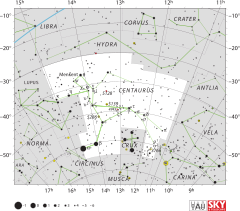Gamma Centauri, Latinized from γ Centauri, is a binary star system in the southern constellation of Centaurus. It has the proper name Muhlifain,[10] not to be confused with Muliphein, which is γ Canis Majoris; both names derive from the same Arabic root. The system is visible to the naked eye as a single point of light with a combined apparent visual magnitude of +2.17;[2] individually they are third-magnitude stars.[3]
| Observation data Epoch J2000 Equinox J2000 | |
|---|---|
| Constellation | Centaurus |
| Right ascension | 12h 41m 31.04008s[1] |
| Declination | −48° 57′ 35.5375″[1] |
| Apparent magnitude (V) | +2.17[2] (+2.85/+2.95)[3] |
| Characteristics | |
| Spectral type | A1IV+[4] (A1IV + A0IV)[5] |
| U−B color index | −0.01[2] |
| B−V color index | −0.01[2] |
| Astrometry | |
| Radial velocity (Rv) | −5.5[6] km/s |
| Proper motion (μ) | RA: −185.72[1] mas/yr Dec.: +5.79[1] mas/yr |
| Parallax (π) | 25.06 ± 0.28 mas[1] |
| Distance | 130 ± 1 ly (39.9 ± 0.4 pc) |
| Absolute magnitude (MV) | −0.81[7] |
| Orbit[8] | |
| Companion | γ Centauri B |
| Period (P) | 83.57±0.21 yr |
| Semi-major axis (a) | 0.869±0.011″ |
| Eccentricity (e) | 0.793±0.003 |
| Inclination (i) | 113.7±0.7° |
| Longitude of the node (Ω) | 2.6±0.7° |
| Periastron epoch (T) | 1,931.25 ± 0.07 |
| Argument of periastron (ω) (secondary) | 187.9±1.5° |
| Details | |
| Mass | 2.91[9] M☉ |
| Surface gravity (log g) | 3.52[4] cgs |
| Temperature | 9,082[4] K |
| Metallicity | −0.29[4] |
| Other designations | |
| Database references | |
| SIMBAD | data |
This system is located at a distance of about 130 light-years (40 parsecs) from the Sun based on parallax. In 2000, the pair had an angular separation of 1.217 arcseconds with a position angle of 351.9°.[3] Their positions have been observed since 1897, which is long enough to estimate an orbital period of 84.5 years and a semimajor axis of 0.93 arcsecond.[11][8] At the distance of this system, this is equivalent to a physical separation of about 93 AU.[12]
The combined stellar classification of the pair is A1IV+;[4] when they are separated out they have individual classes of A1IV and A0IV,[5] suggesting they are A-type subgiant stars in the process of becoming giants. The star Tau Centauri is relatively close to Gamma Centauri, with an estimated separation of 1.72 light-years (0.53 parsecs).[9] There is a 98% chance that they are co-moving stars.[8]
Etymology
In Chinese astronomy, 庫樓 (Kù Lóu), meaning Arsenal, refers to an asterism consisting of γ Centauri, ζ Centauri, η Centauri, θ Centauri, 2 Centauri, HD 117440, ξ1 Centauri, τ Centauri, D Centauri and σ Centauri.[13] Consequently, the Chinese name for γ Centauri itself is 庫樓七 (Kù Lóu qī, English: the Seventh Star of Arsenal).[14]
The people of Aranda and Luritja tribe around Hermannsburg, Central Australia named a quadrangular arrangement comprising this star, δ Cen (Ma Wei), δ Cru (Imai) and γ Cru (Gacrux) as Iritjinga ("The Eagle-hawk").[15]
